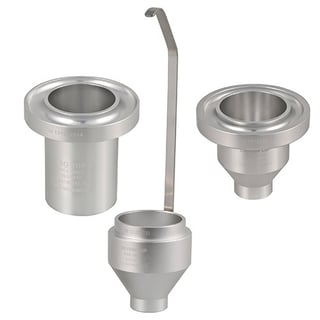The viscosity is a physical quantity that indicates the resistance of a fluid to flow. In other words it is a value that indicates how much a liquid tends to drag with all of its elements that compose it rolls along a surface. To do some practical example, the water is a non-viscous liquid, while the oil is a liquid with a higher viscosity.
We decided to explore this topic because the viscosity is one of the main features of a leather edge paint, and in some cases it is decisive for a good finishing of a leather edge.
How do you measure the viscosity?
In the International System of measurement, the dynamic viscosity is measured in Poiseuille (or its submultiples), even if in the commercial and industrial world is usually measured in "seconds", since one of the most common (and cheaper) tool for the measurement of viscosity is the cup of runoff.
It consists of a cup which is filled with the liquid to be measured, then calculating the time that the liquid takes to empty it completely. This time indicates the viscosity of the liquid in seconds. More time is required for liquid to flow out from the cup, higher will be its viscosity.
Examples of cups for measuring the viscosity.
From what the viscosity can be influenced?
Since the viscosity of a liquid is a value determined from the bonds of its molecules, this value may vary if influenced by external agents, such as for example the temperature or mechanical action. Generally the viscosity decreases with increasing temperature, or when a liquid is subjected to a mechanical action (such as a liquid under stirring).
Why is it important that a Leather Edge Paint has the correct viscosity?
Precisely for its characteristic of "drag with it all the elements of which it is composed when flowing along a surface" the viscosity of a Leather Edge Paint is one of the features that determines the good applicability. Leather edge paints from GIARDINI have all been developed to always maintain a range of optimum viscosity, facilitating its applicability on the leather edge, according to your requirements it can be used the DENSE EDGE PAINT or BASIC EDGE PAINT, which have features of different viscosity (and beyond).
What happens if my Leather Edge Paint is too liquid?
Since the viscosity can changes in temperature, it will be noticed during the course of the seasons a change in viscosity of the product caused by the storage temperature: do not worry, this does not change the technical characteristics of the product once dry.
In the event that in your work environment is really too hot and the leather edge paint is too liquid for a good application, you can store it in the refrigerator (never below 5 ° C) and you will always have the paint with the maximum density!


